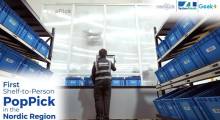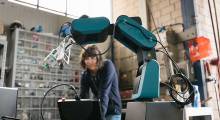Think of a torture chamber. For totes, bins and trays, that is. What exactly would you like to see inflicted on them? Maybe some extreme heat. How about highly corrosive chemicals. Now we’re talking. Why not some excruciatingly cold temperatures. And, oh, yes, let’s just see what kind of compression pressures they can withstand. As you already know, the testing machine always wins.
That all sounds good to the engineers at the Molded Fiber Glass Tray Company’s Research Center. While they’re all nice guys, being unkind to fiberglass containers is just another day in the lab for them. That’s what marketing manager Celena Davis discovered the other day when she visited the center for the first time. More importantly, she saw why all this testing is so important.
At the Modex show next March in Atlanta, MFG Tray will introduce a new product. And everyone wants to be sure they get it right. Now, the company has been making highly durable totes, bins and trays for more than 65 years. In fact, it’s not uncommon for Burt Hovis, material handling product line manager, to receive an inquiry or package with trays the company made more than 20 years ago. They usually come with a request—could MFG Tray replace them, they’re starting to wear out.
So, there’s a history of longevity for MFG Tray products. But there’s more on the line this time around, says Hovis.
What’s new is a line of lightweight molded fiberglass bins, trays and totes. The goal is ambitious, to say the least—remove 40% of the weight. That will allow them to carry more product without ergonomic concerns for handlers.
But lighter weight usually means less strength. However, the new product MFG Tray has formulated needs to be durable just like the stuff made 20 years ago. These new items are 40% lighter than standard products while still being manufactured from fiberglass to withstand many years of use and wear.
But they’ve handicapped their effort from the start. It’s very common for thermoplastic items to add ribs (yes, just as you are imagining) to add more strength in thinner sections. But Hovis says the company will not include ribs in these new composite parts. They want to maximize utility of the containers in not-so-gentle manufacturing operations.
As the company well knows, making that happen doesn’t just happen. MFG Tray works with highly proprietary blends of fiberglass reinforced thermoset composite commonly known as SMC (sheet molded compound). Getting it just right takes some time and a lot of test blends.
Meanwhile, the engineers have to break some containers along the way. That’s what Davis went to go see that day at the research center. They are getting close to the right formulation that will carry the day at Modex.
If you have a chance at the show, you may want to stop in and ask for Burt. He will have a story to tell you about what it took to get those containers to the Georgia World Congress Center and what they can do for you after the show.
Article topics








